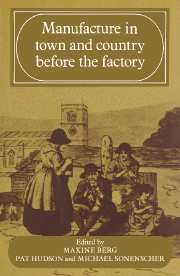Book contents
- Frontmatter
- Contents
- List of illustrations
- Acknowledgements
- 1 Manufacture in town and country before the factory
- 2 Political economy and the principles of manufacture 1700–1800
- PART I THE STRUCTURE OF MANUFACTURE
- PART II ‘WORK’ AND ‘WAGES’
- 6 Work and wages in Paris in the eighteenth century
- 7 Embezzlement, industry and the law in England, 1500–1800
- Appendix 1 Norwich embezzlement convictions in the eighteenth century: problems of evidence
- Appendix 2 Estimates of the size of the supplement to wages available through embezzlement in two eighteenth-century industries
- Appendix 3 Statutes concerned with embezzlement in the putting-out industries, 1500–1800
- Index
7 - Embezzlement, industry and the law in England, 1500–1800
Published online by Cambridge University Press: 16 October 2009
- Frontmatter
- Contents
- List of illustrations
- Acknowledgements
- 1 Manufacture in town and country before the factory
- 2 Political economy and the principles of manufacture 1700–1800
- PART I THE STRUCTURE OF MANUFACTURE
- PART II ‘WORK’ AND ‘WAGES’
- 6 Work and wages in Paris in the eighteenth century
- 7 Embezzlement, industry and the law in England, 1500–1800
- Appendix 1 Norwich embezzlement convictions in the eighteenth century: problems of evidence
- Appendix 2 Estimates of the size of the supplement to wages available through embezzlement in two eighteenth-century industries
- Appendix 3 Statutes concerned with embezzlement in the putting-out industries, 1500–1800
- Index
Summary
Historians have differed over the precise advantages that putting-out offered the master manufacturer relative to other available methods of organising industrial production, but there is virtual unanimity that the principal disadvantage of putting-out for the employer was the difficulty of supervising the labour force and, in particular, the problem of embezzlement by workers. Indeed it has been argued that the key to the shift to centralised production by some employers in the late eighteenth century was not the technical superiority of factory-based technologies, but rather the extent of embezzlement and associated problems of labour discipline under the putting-out system.
There are dangers of exaggeration here. Just as the factory did not give the employer absolute control over the labour process in general, neither did it abolish at a stroke the illegal appropriation by the workforce of goods in the process of manufacture. Nor, before the coming of the factory, was such appropriation confined to the putting-out sector. The eighteenth-century dockyards, where production was concentrated on single sites, were notorious for their workers' pilfering of wood, ropes, canvas and other naval stores. Similarly coal miners took coal from the pits. Employees in small workshops made similar appropriations. Apprentices were especially suspect.
Though frauds during the process of manufacture were by no means confined to industrial organisation of the putting-out type, the character of such frauds under the putting-out system was in two respects distinctive. First, as historians have long recognised, concentration of the ownership of the raw materials, combined with the remoteness of the owner from the point of manufacture, made for special problems of supervision and provided peculiar opportunities for fraud.
- Type
- Chapter
- Information
- Manufacture in Town and Country Before the Factory , pp. 173 - 205Publisher: Cambridge University PressPrint publication year: 1983
- 13
- Cited by



